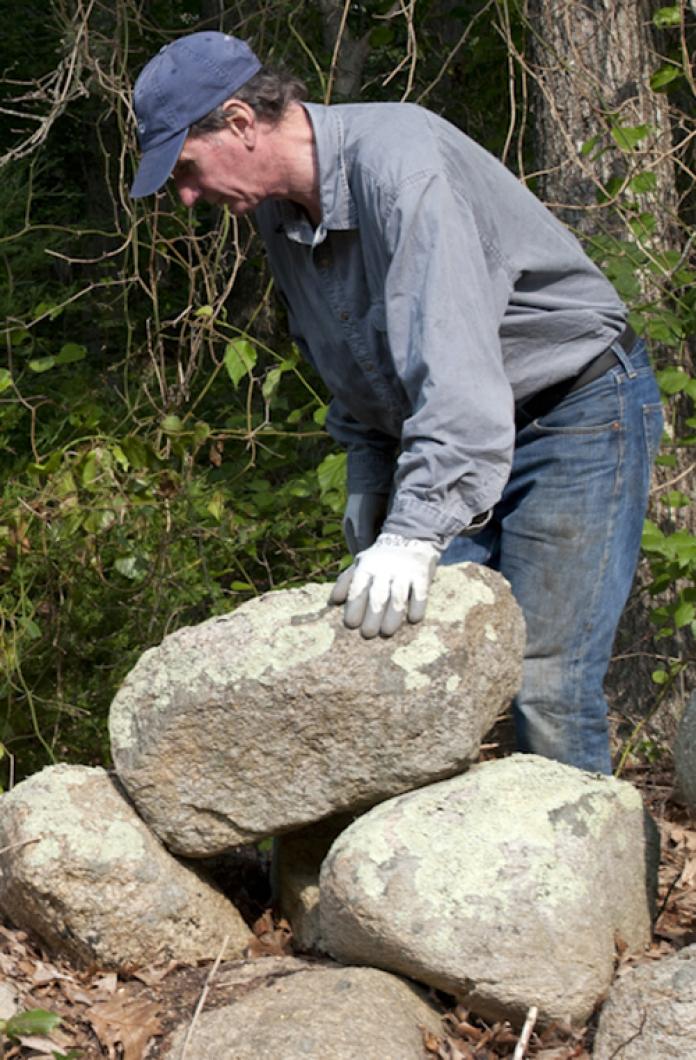Boulders, looking like the playthings of giants, are strewn over the rolling banks of South Road. Tumbling down from the walls, the rocks stand guard at this thoroughfare as they have done for hundreds of years, witnesses to all that has happened here, even as they shift with the changes in land and weather.
But with the passage of time, the walls have crumbled, and these structures, seemingly solid and immovable, are in need of repair. Stretching several hundred feet from Meeting House Road towards West Tisbury, the walls are being revived by stonemason John Maloney and his son, Owen Maloney.
Michael Van Valkenburgh, a landscape architect and seasonal Chilmark resident, raised money for this particular project, an undisclosed amount which was matched by the adjacent property owners. He has been involved in several projects of wall restoration in the town over the past few years, after he learned of a Chilmark program that gave grants for roadside-stonewall owners who wished to repair the crumbling stone.
The Chilmark Historical Commission, which has contributed money to wall restoration in years past, is not involved in this particular project. Town meeting this year approved $20,000 from the Community Preservation Act funds to already-committed stonewall restoration projects along the public roadsides. At the moment, the Chilmark Historical Commission is interested in restoring some walls on Middle Road, although there are no current plans.
Jane Slater, who serves on the Chilmark Historical Commission in addition to several other town positions and writes the Chilmark town column for the Gazette, said, “At the moment, the Chilmark Historical Commission is not financing any restorations, but we are always very happy when people want to restore roadside walls, especially when they want to make it look like an old Chilmark wall.”
In order to receive funding from the town historical commission, property owners wishing to restore walls must write a letter to the historical commission, requesting funds. If the commission agrees, they provide some funds and put the restoration out to bid among competing stonemasons.
The South Road effort, however, is a private project, undertaken by Mr. Van Valkenburgh. The State of Massachusetts formally owns the land on which the walls sit, but it often falls to private initiative to maintain them to an exacting aesthetic standard. It is in projects such as this that Mr. Van Valkenburgh complements what the state or town is willing to contribute.
For him, the project is as much aesthetic as it is historical. “It’s about making up-Island beautiful, but by doing this, there’s also the chance that the history and feeling of South Road will be improved when the walls are visible again.”
He has found a kindred spirit in John Maloney. “I said to John that I thought it would be more poetic if the walls weren’t restored to perfection. I was worried that he’d want to make them into a solid block, but he said, ‘Oh, no, that would be terrible. It would be a tragedy to stiffen it and make it new.’”
And in his efforts to clear the vines that have strangled these walls, John Maloney has made some discoveries. At the end of the section of wall they’re restoring, they discovered a perfect corner: two enormous flat rocks sit atop a row of smaller stones, pebbles in comparison. “We found this the other day,” he said. “It’s just amazing — we didn’t even have to touch it.”
That ability to strike a perfect balance, to achieve a timelessness that brings this Island’s agricultural past into its present takes both skill, which Mr. Van Valkenburgh knew John Maloney possessed, and an appreciation for the tradition of which these walls are a part. Without that, the walls could be transformed into heavy slabs instead of the gray waves that dip and swell with the landscape.
The walls form an important part of Chilmark’s history, agricultural and otherwise.
“These walls along South Road span hundreds of years, they are truly ancient,” said Mr. Van Valkenburgh. “It’s kind of an amazing register of the history here — of working the land, working the fields and clearing the stone to put these walls together.”
It comes back to the stones that stand as the true bearers of an historical legacy. Community recognition is essential to their preservation, and hopefully this restoration will bring that message home. Mr. Van Valkenburgh said, “I’m hoping this will inspire other people in town to say, ‘Oh, wow, that looks great. We should do more of it.’”




Comments (1)
Comments
Comment policy »